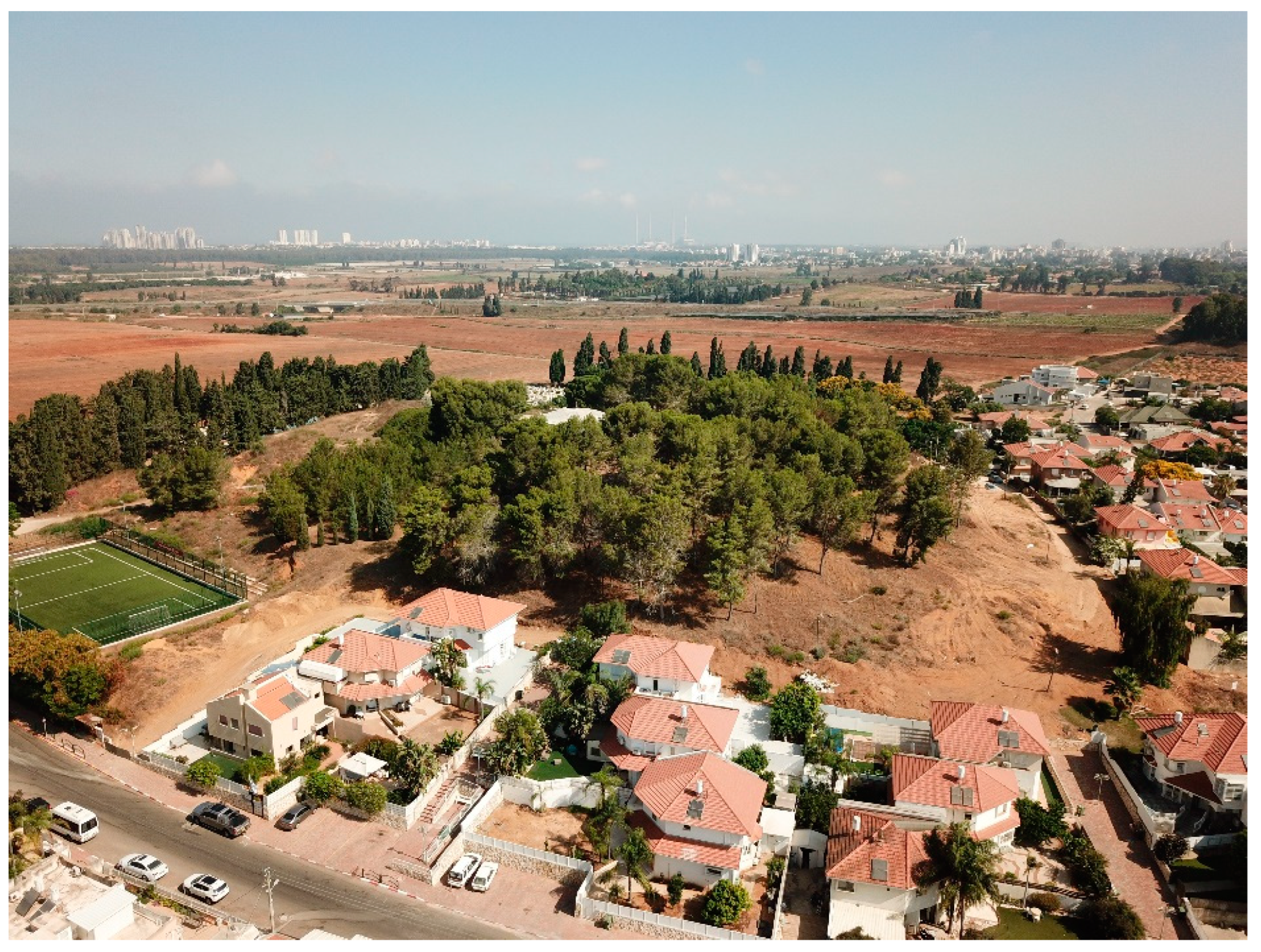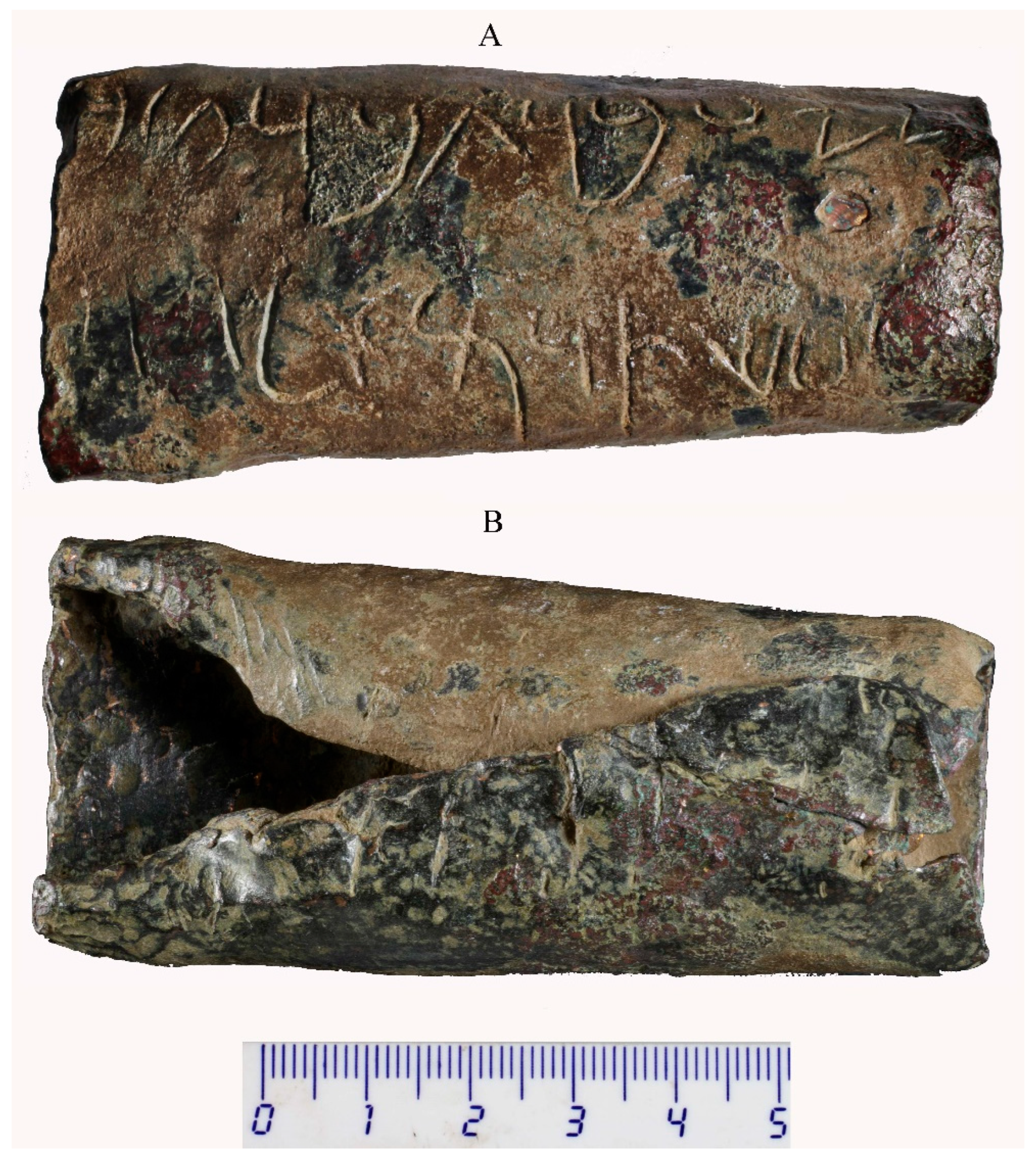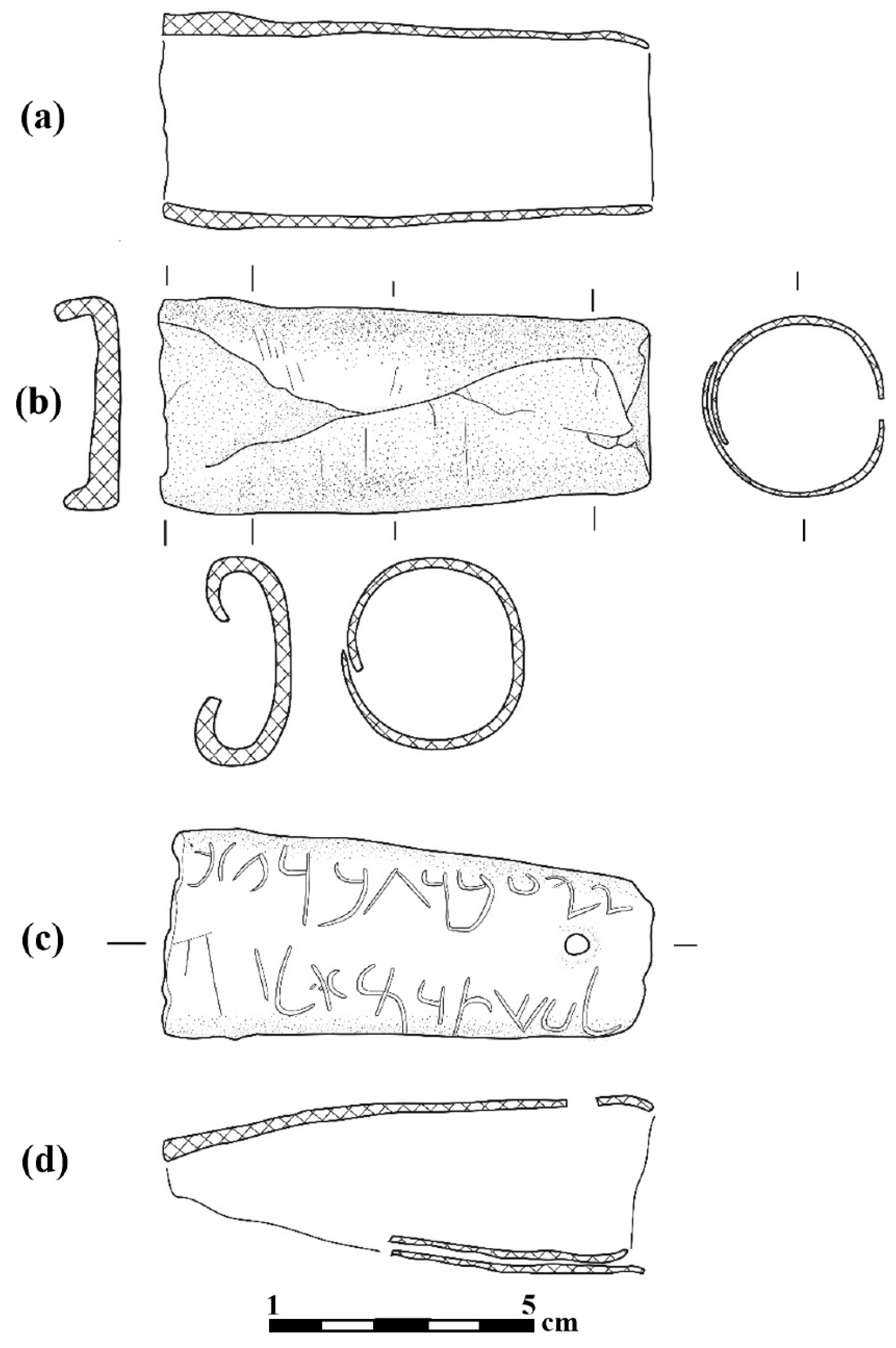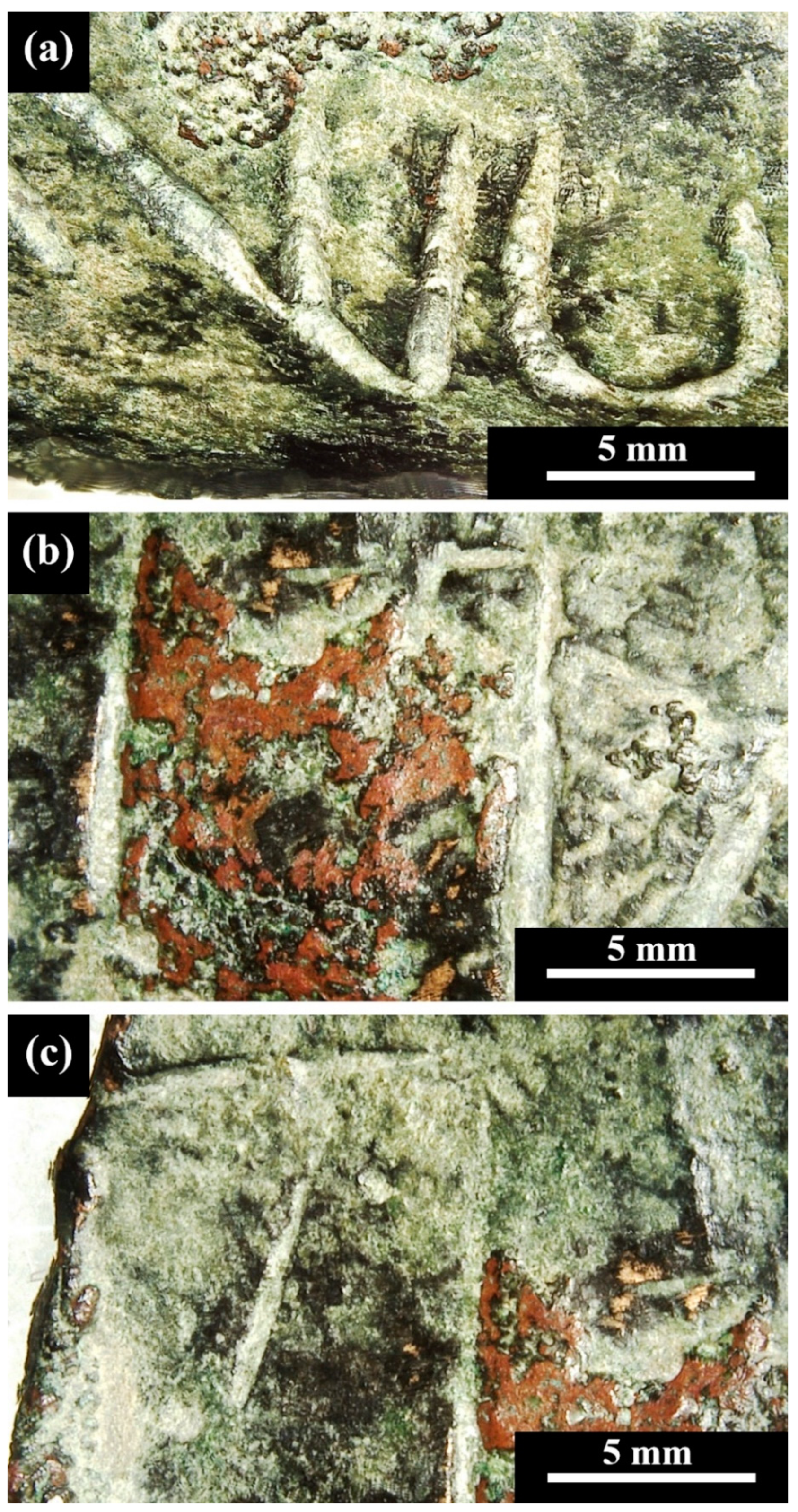Metallurgical Characterization of a Copper-Alloy Aramaic-Inscribed Object from Tulûl Mas‘ud (Elyakhin)
Abstract
:1. Introduction
1.1. General Description of the Discovery of the Incised Aramaic Inscription
1.2. The Site of Tulûl/Tell Mas‘ud
1.3. The Object: Technical Description
1.4. The Aramaic Inscription
- זי עבד גברט̇ב[…] That which Gbrṭb made […]
- […[ °°לעשתרמ אל To ‘strm ’l °° […]
2. Metallurgical Background
3. Experimental Methods and Tests
- (a)
- VT inspection was carried out to examine the state of preservation of the object and to detect macroscopic level details that can indicate the manufacturing process.
- (b)
- HH-XRF chemical analysis was carried out using an Oxford X-MET8000 instrument with silicon drift detector, equipped with a 45 kV Rh target X-ray tube. Each measurement was performed for 30 s on a detected area of 5 mm in diameter, inside a bench-top stand. The HH-XRF instrument was calibrated with standard calibration samples made of copper and copper-bronze (11.1 wt. % Sn). Such instruments can measure alloy elements to within an accuracy of up to 0.5% of the measured value. The HH-XRF analysis of the object’s exterior surface may not be representative of its bulk composition owing to the thick patina layer and surface corrosion. The elemental composition of the patina layer and corrosion products can be enriched in certain trace elements and is often depleted in copper concentration in comparison with bulk metal. The reliability of the measurements can be improved by removing the patina layer and corrosion products [22,29]. Consequently, the external surface of the object was roughly sanded using a 320 grit silicon carbide abrasive paper to expose the bulk metal and then cleaned with ethanol. The HH-XRF approach presents a challenge in differentiating between the peaks of As and Pb, owing to the low level of peak overlap. The HH-XRF measurements were thus performed through a comparison of two independent peaks: As Kα was compared to Pb Mα and As Kβ peak was compared to Pb Lβ [29].
- (c)
- The surface of the object was observed using a HIROX RH-2000 digital multifocal LM equipped with powerful software, encoded optics, high intensity LED lighting, and a light sensitivity sensor at high-resolution HD (1920 × 1200), presenting high pixel density and low image noise. This advanced tool allows the following of surface colours, topographies, and morphologies [36].
4. Results and Discussion
5. Conclusions
Author Contributions
Funding
Institutional Review Board Statement
Data Availability Statement
Acknowledgments
Conflicts of Interest
References
- Lewis, R.Y.; Finkelstein, N.; Avissar Lewis, R.S.; Eshel, E.; Baruch, Y.; Maor, Y.; Tsach, T.; Tal, O. An Aramaic-inscribed object from Tulûl Mas‘ud (Elyakhin). Atiqot 2023, 110. in press. [Google Scholar]
- Conder, C.R.; Kitchener, H.H. Map of Western Palestine; Palestine Exploration Fund: London, UK, 1880. [Google Scholar]
- Tulûl Mas‘ud. Survey of Israel Archive; IAA: Jerusalem, Israel, 2014–2020/2021. [Google Scholar]
- Busheri, M. A statue from the Persian Period in Elyakhin. Hadashot Arkheol. 1965, 14, 10. (In Hebrew) [Google Scholar]
- Porath, Y.; Dar, S.; Applebaum, S. The History and Archaeology of Emek-Hefe; Hakibbutz Hameuchad—Sifriat Poalim: Tel Aviv, Israel, 1985. (In Hebrew) [Google Scholar]
- Gophna, R.; Kochavi, M. The archaeological survey of the Sharon. Hadashot Arkheol. 1966, 17, 13. (In Hebrew) [Google Scholar]
- Gophna, R.; Kochavi, M. Notes and news—An archaeological survey of the Plain of Sharon. Israel Explor. J. 1966, 16, 143–144. [Google Scholar]
- Ne’eman, Y. The Plain of Sharon Survey; The Khan Museum Archives: Hadera, Israel, 1990; 5-333-9, file 2. [Google Scholar]
- Ne’eman, Y.; Sender, S.; Oren, E. Map of Mikhmoret (52); Map of Hadera (53); Archaeological Survey of Israel: Jerusalem, Israel, 2000. [Google Scholar]
- Giveon, R. Three fragments of statuary from the Northern Sharon. Yediot BeHaqirat Eretz-Isr. WeAtiqoteha 1967, 31, 118–123. (In Hebrew) [Google Scholar]
- Giveon, R. Footsteps of Pharaoh in Canaan: Essays on the land of Israel and ancient Egypt; Hakibbutz Hameuchad—Sifriat Poalim: Tel. Aviv, Israel, 1984. (In Hebrew) [Google Scholar]
- Deutsch, R.; Helzer, M. Forty New Ancient West Semitic Inscriptions; Archaeological Center Publications: Tel Aviv, Israel, 1994. [Google Scholar]
- Deutsch, R.; Helzer, M. Numismatic evidence from the Persian Period from the Sharon Plain. Transeuphratène 1997, 13, 17–22. [Google Scholar]
- Lemaire, A. Scripts of post-iron age Aramaic inscriptions and ostraca. In An Eye for Form: Epigraphic Essays in Honor of Frank Moore Cross; Hackett, A., Aufrecht, W.E., Eds.; Penn State University Press: Winona Lake, Kosciusko, 2014; pp. 235–252. [Google Scholar]
- Eshel, E. Combining different types of scripts in the Aramaic texts. In The Scribe in the Biblical WorldII; Eshel, E., Langlois, M., Eds.; Orbis Biblicus et Orientalis 22: Freiburg, Germany, in press.
- Wyatt, N. ASTARTE עשתרת. In Dictionary of Deities and Demons in the Bible (DDD), 1st ed.; van der Toorn, K., Becking, B., van der Horst, P.W., Eds.; Brill: Leiden, The Netherlands; New York, NY, USA, 1995; pp. 203–213. [Google Scholar]
- Zadok, R. On West Semites in Babylonia during Chaldean and Achaemenian Period: An Onomastic Study; H.J. & Z. Wanaarta: Jerusalem, Israel, 1977. [Google Scholar]
- Lipiński, E. The cult of ‘Ashtarum in Achaemenian Palestine’. In Biblia et Semitic: Studi in Memoria di Francesco Vattioni; Cagni, L., Ed.; Napoli Istituto Universitario Orientale: Naples, Italy, 1999; pp. 315–323. [Google Scholar]
- Kottsieper, I. ŠTRM: Eine südarabische Gottheit in der Scharonebene. Z. Für Die Alttest. Wiss. 2011, 113, 245–250. [Google Scholar] [CrossRef]
- Prioletta, A. Evidence from a new inscription regarding the Goddess ‘ṯ(t)rm and some remarks on the gender of deities in South Arabia. Proc. Semin. Arab. Stud. 2012, 42, 309–318. [Google Scholar]
- Chen, L.B. Sumerian arsenic copper and tin bronze metallurgy (5300–1500 BC): The archaeological and cuneiform textual evidence. Archaeol. Discov. 2021, 9, 185–197. [Google Scholar] [CrossRef]
- Muşkara, Ü.; Aydın, M. Elements analysis of Pre-Pottery Neolithic B copper finds from Filla. Mediterr. Archaeol. Archaeom. 2022, 22, 1–14. [Google Scholar]
- Oudbashi, O.; Wanhill, R. Archaeometallurgy of copper and silver alloys in the old world: The production and processing of advanced materials, Namely metals and alloys, began in the old world about 8000 years ago and developed over many millennia, providing a lasting legacy for modern civilizations. Adv. Mater. Proc. 2021, 179, 24–28. [Google Scholar]
- Shotten-Hallel, V.; Ashkenazi, D.; Tal, O. Archaeometallurgical analysis of thirteenth-century bronze and iron construction implements from the walls of the Frankish Castle at Arsuf/Arsur. Metallogr. Microstruct. Anal. 2022, 11, 255–280. [Google Scholar] [CrossRef]
- Garfinkel, Y.; Klimscha, F.; Shalev, S.; Rosenberg, D. The beginning of metallurgy in the Southern Levant: A Late 6th Millennium CalBC copper awl from Tel Tsaf, Israel. PLoS ONE 2014, 9, e92591. [Google Scholar] [CrossRef] [PubMed]
- Ashkenazi, D.; Bunimovitz, S.; Stern, A. Archaeometallurgical investigation of thirteenth–twelfth centuries BCE bronze objects from Tel Beth-Shemesh, Israel. J. Archaeol. Sci. Rep. 2016, 6, 170–181. [Google Scholar] [CrossRef]
- Turner-Walker, G. A Practical Guide to the Care and Conservation of Metals; Taiwan Headquarters Administration for Cultural Heritage, Council for Cultural Affairs: Taiwan, China, 2008. [Google Scholar]
- Scott, D.A. Metallography and Microstructure of Ancient and Historic Metals; The Getty Conservation Institute: Singapore, 1991. [Google Scholar]
- Bram, M.; Iddan, N.; Ashkenazi, D.; Cvikel, D. The nineteenth-century Molyneux’s boat: Archaeometallurgical perspective of its metal fastenings. Metallogr. Microstruct. Anal. 2020, 9, 721–743. [Google Scholar] [CrossRef]
- Papadopoulou, O.; Vassiliou, P. The influence of archaeometallurgical copper alloy castings microstructure towards corrosion evolution in various corrosive media. Corros. Mater. Degrad. 2021, 2, 227–247. [Google Scholar] [CrossRef]
- Ashkenazi, D.; Iddan, N.; Tal, O. Archaeometallurgical characterization of Hellenistic metal objects: The contribution of the bronze objects from Rishon Le-Zion (Israel). Archaeometry 2012, 54, 528–548. [Google Scholar] [CrossRef]
- Vale’rio, P.; Silva, R.J.C.; Soares, A.M.M.; Arau’jo, M.F.; Fernandes, F.M.B.; Silva, A.C.; Berrocal-Rangel, L. Technological continuity in Early Iron Age bronze metallurgy at the South-Western Iberian Peninsula—A sight from Castro dos Ratinhos. J. Archaeol. Sci. 2010, 37, 1811–1819. [Google Scholar] [CrossRef]
- Iddan, N.; Ashkenazi, D.; Klein, S.; Cvikel, D. Metallurgical analysis of a bronze powder chamber retrieved from an underwater excavation in Akko (Israel): An application of novel minimally destructive field multi-focal metallography. Archaeol. Anthropol. Sci. 2022, 14, 131. [Google Scholar] [CrossRef]
- Razok, S.T. Copper-based alloys in the Jezirah during the third millennium BC in light of archaeological evidence and laboratory analyses. J. Cult. Herit. 2021, 52, 11–22. [Google Scholar] [CrossRef]
- Ingo, G.M.; De Caro, T.; Riccucci, C.; Angelini, E.; Grassini, S.; Balbi, S.; Bernardini, P.; Salvi, D.; Bousselmi, L.; Çilingiroglu, A.; et al. Large scale investigation of chemical composition, structure and corrosion mechanism of bronze archeological artefacts from Mediterranean Basin. Appl. Phys. A 2006, 83, 513–520. [Google Scholar] [CrossRef]
- Ashkenazi, D.; Cvikel, D. A journey into the microstructure: Using a multifocal 3D digital light microscope to study archaeological artefacts retrieved from shipwrecks. Digit. Appl. Archaeol. Cultur. Herit. 2020, 16, e00129. [Google Scholar] [CrossRef]
- Dungworth, D.B. Iron Age and Roman Copper Alloys from Northern Britain. PhD. Thesis, Durham University, Durham, UK, 1995. [Google Scholar]
- Nnakwo, K.C.; Mbah, C.N.; Nnuka, E.E. Influence of trace additions of titanium on grain characteristics, conductivity and mechanical properties of copper-silicon-titanium alloys. Heliyon 2019, 5, e02471. [Google Scholar] [CrossRef] [PubMed] [Green Version]
- Nnakwo, K.C.; Osakwe, F.O.; Ugwuanyi, B.C.; Oghenekowho, P.A.; Okeke, I.U.; Maduka, E.A. Grain characteristics, electrical conductivity, and hardness of Zn-doped Cu–3Si alloys system. SN Appl. Sci. 2021, 3, 829. [Google Scholar] [CrossRef]
- Ashkenazi, D.; Inberg, A.; Cvikel, D. Analysis of naturally etched surface of brass sheathing from a nineteenth-century shipwreck. J. Min. Metallur. B 2018, 54, 101–110. [Google Scholar] [CrossRef]






| Measured Item Description | Composition (wt. %) | ||||||
|---|---|---|---|---|---|---|---|
| Cu | Sn | Si | Fe | As | Zn | Other Elements | |
| Patina cover, area 1 (no sanding) | 74.4 | 0.8 | 21.9 | 1.0 | 0.2 | 0.1 | 0.2 P, 1.4 Al |
| Patina cover, area 2 (no sanding) | 76.7 | 0.9 | 19.3 | 1.0 | 0.2 | 0.1 | 0.3 P, 1.5 Al |
| Patina cover, area 3 (no sanding) | 80.2 | 0.7 | 17.9 | 0.9 | 0.2 | 0.1 | – |
| Metal, area 1 (locally sanded) | 90.3 | 0.9 | 7.7 | 0.5 | 0.3 | 0.1 | 0.2 P |
| Metal, area 2 (locally sanded) | 91.0 | 0.9 | 7.2 | 0.5 | 0.3 | 0.1 | – |
| Metal, area 3 (locally sanded) | 93.6 | 0.8 | 4.8 | 0.5 | 0.2 | 0.1 | – |
| Metal, area 4 (locally sanded) | 96.4 | 0.9 | 2.0 | 0.4 | 0.2 | 0.1 | – |
| Metal, area 5 (locally sanded) | 89.4 | 0.7 | 8.9 | 0.7 | 0.2 | 0.1 | – |
| Metal, area 6 (locally sanded) | 89.7 | 0.7 | 8.7 | 0.6 | 0.2 | 0.1 | – |
| Metal, area 7 (locally sanded) | 95.4 | 0.8 | 3.0 | 0.4 | 0.2 | 0.1 | 0.1 S |
| Metal, area 8 (locally sanded) | 93.4 | 0.8 | 5.1 | 0.4 | 0.2 | 0.1 | – |
Publisher’s Note: MDPI stays neutral with regard to jurisdictional claims in published maps and institutional affiliations. |
© 2022 by the authors. Licensee MDPI, Basel, Switzerland. This article is an open access article distributed under the terms and conditions of the Creative Commons Attribution (CC BY) license (https://creativecommons.org/licenses/by/4.0/).
Share and Cite
Ashkenazi, D.; Lewis, R.Y.; Eshel, E.; Tal, O. Metallurgical Characterization of a Copper-Alloy Aramaic-Inscribed Object from Tulûl Mas‘ud (Elyakhin). Humans 2022, 2, 177-189. https://doi.org/10.3390/humans2040012
Ashkenazi D, Lewis RY, Eshel E, Tal O. Metallurgical Characterization of a Copper-Alloy Aramaic-Inscribed Object from Tulûl Mas‘ud (Elyakhin). Humans. 2022; 2(4):177-189. https://doi.org/10.3390/humans2040012
Chicago/Turabian StyleAshkenazi, Dana, Rafael Y. Lewis, Esther Eshel, and Oren Tal. 2022. "Metallurgical Characterization of a Copper-Alloy Aramaic-Inscribed Object from Tulûl Mas‘ud (Elyakhin)" Humans 2, no. 4: 177-189. https://doi.org/10.3390/humans2040012
APA StyleAshkenazi, D., Lewis, R. Y., Eshel, E., & Tal, O. (2022). Metallurgical Characterization of a Copper-Alloy Aramaic-Inscribed Object from Tulûl Mas‘ud (Elyakhin). Humans, 2(4), 177-189. https://doi.org/10.3390/humans2040012







